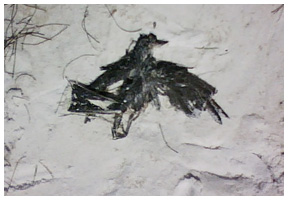
Recent events wreaks havoc for migratory birds
Whether recent bird deaths directly related to oil rig disaster is not yet determined
There have been several reports of numerous dead birds found along the beaches of the Florida Panhandle.
Don Ware, bird count coordinator of the Choctawhatchee Audubon Society and Stephanie Torr of Old Florida Village took a walk along South Walton’s Seacrest Beach on April 24 to assess the incident of dead birds washing up on shore.
Don and Stephanie spotted several migratory species in South Walton, and Don continued to west to Santa Rosa Sound in Okaloosa County and observed several more dead birds along the shoreline.
Many different species were found dead including scarlet tanagers, Audubon’s shearwaters, rose-breasted grosbeaks, least storm petrels, indigo buntings, eastern kingbirds and American redstarts to name a few.
Don’s consensus was that the birds became weary traveling from as far south as the Yucatan Peninsula during peak migratory season. Getting caught in the bad storm front that came through on April 22 and 23 made it even more difficult for the migrants success.
“Getting caught in the storm just made it worse,” Don said as he spoke on how the birds travel so far without a resting spot or food source.
Denise Rowell, public affairs officer with the U.S. Fish and Wildlife Service in Panama City, Fla. agreed with Don’s consensus. She said this is not all that uncommon during migratory season.
“We do not believe this is a contaminant issue,” Denise said.
Dr. John G. Himes, Northwest Regional Biologist for Florida Fish and Wildlife Conservation Commission (FWC) is not sure of the cause of so many deaths, and has sent a bird that Don Ware collected to their Gainsville, Fla. lab for a necropsy.
Dr. Himes would like the public to help FWC determine the source of these unnatural events. If you find a dead bird on the beach, you can help the FWC by filling out a report form on their bird mortality database at: http://MyFWC.com/bird.
If you find a bird that has been deceased for less than 24 hours, you can send it to FWC through the database information form.

Taryn Seeley
April 27, 2010Took a walk on Pass-a-Grille Beach today in St. Petersburg, FL and there were sooooo many dead birds, even large shore birds. And they say off shore drilling is safe, for who, their bankers?
Allison Mills April 28
April 29, 2010I took a walk along the beach at Topsail state park,FL. And saw many dead birds including a few hummingbirds,ducks and even some birds that do not migrate. That was on the 25th. So I am not sure if I believe the whole caught in a storm migrating.
Walton Outdoors
April 29, 2010Thank you Allison,
We might not ever know why so many birds perished over that weekend, and it has many folks concerned. FWC cannot successfully do a necropsy on a bird unless it has been found right after it has perished and sent to them within 24 hrs.
Kathleen Reed
May 1, 2010I experienced a severe thunderstorm system, as it came ashore in southwest central Florida, last Sunday night, and it was VERY powerful. It started around 9 PM, where I was, and it lasted through most of the night, with high winds, tornados and heavy rains. I can *easily* believe the theory that a bird, caught over open water in that maelstrom, could become exhausted and drown.